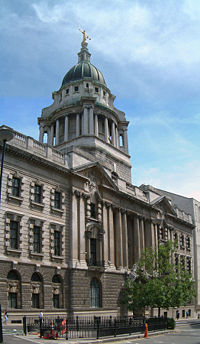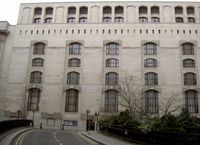Old Bailey
2008/9 Schools Wikipedia Selection. Related subjects: Law
The Central Criminal Court in England, commonly known as the Old Bailey, is a court building in central London, one of a number housing the Crown Court. The Crown Court sitting at the Central Criminal Court deals with major criminal cases from Greater London and, exceptionally, from other parts of England. It stands on the site of the mediaeval Newgate Gaol, on Old Bailey, a road which follows the line of the City's fortified wall (or bailey), and gives the court its popular name. It lies between Holborn Circus and St Paul's Cathedral.
The building and its history
The original mediaeval court was located on the western wall of the City of London, but was destroyed in the 1666 Fire of London. It was rebuilt in 1674, with the court open to the weather to prevent the spread of disease. In 1734 it was refronted, enclosing the court and reducing the influence of spectators: this led to outbreaks of typhus, notably in 1750 when sixty people died, including the Lord Mayor and two judges. It was rebuilt again in 1774 and a second courtroom was added in 1824. In 1834 it was renamed as the Central Criminal Court and its jurisdiction extended.
The Court was originally for trial only of crimes committed in the capital but in 1856, public revulsion at the accusations made against doctor William Palmer, that he was a poisoner and murderer, led to fears that he could not enjoy a fair trial in his native Staffordshire. The Central Criminal Court Act 1856 was passed to enable his trial to be held at the Old Bailey.
The present building dates from 1902 (officially opened on 27 February 1907), was designed by E.W. Mountford and built on the site of the infamous Newgate Prison, which was demolished to allow the Courts to be built. Above the main entrance is inscribed "Defend the Children of the Poor & Punish the Wrongdoer". King Edward VII personally opened the courthouse.
On the dome above the court stands a statue of Lady Justice by British sculptor F. W. Pomeroy. She holds a sword in her right hand and a pair of weighing scales in her left (representing Blind Equality). The statue is popularly supposed to show Blind Justice, with the figure depicted wearing a blindfold, but there is in fact no blindfold present.
During the Blitz, the Old Bailey was bombed and severely damaged, but subsequent reconstruction work restored most of it in the early 1950s. In 1952 the restored interior of the Grand Hall of the Central Criminal Courts was once again open.
From 1968 to 1972 a new South Block, designed by the architects Donald McMorran and George Whitby, was built containing more modern courts.
The Old Bailey celebrated its 100th Birthday on 27 February 2007 with a Reception attended by Queen Elizabeth II.
Judges
All judges sitting in the Old Bailey are, unusually, addressed as "My Lord" or "My Lady" whether they be High Court, circuit judges or Recorders. The Lord Mayor of London and aldermen of the City of London are entitled to sit on the judges' bench during a hearing but do not actively participate in trials.
The most senior permanent judge of the Central Criminal Court has the title of the Recorder of London, and his deputy has the title of Common Serjeant of London. The present Recorder of London is His Honour Judge Peter Beaumont QC, who was appointed in December 2004 following the death earlier that year of his predecessor, His Honour Judge Michael Hyam. The present Common Serjeant is His Honour Judge Brian Barker QC. The position of Recorder of London should not be confused with that of Recorder, which is the name given to lawyers who sit part-time as Crown Court judges. A select number of the most senior criminal lawyers in the country sit at as Recorders in the Central Criminal Court.
Sir John Mortimer, a criminal barrister and author, often appeared at the Old Bailey. His courtroom experiences led him to create the fictional character Horace Rumpole, alias Rumpole of the Bailey.
In popular culture
- In the book A Tale of Two Cities by Charles Dickens, the Old Bailey is the courthouse named in the book where Charles Darnay is put on trial for treason.
- In the novel Patriot Games and the eponymous film, terrorist Sean Miller is tried in the Old Bailey.
- The Old Bailey is destroyed by the character V in the graphic novel V for Vendetta and its film adaptation.
- The television series Rumpole of the Bailey concerns a defence lawyer who works at the Bailey.
- In the popular Australian folk song " Botany Bay", the first verse references the "well known Old Bailey". The song tells the tale of a group of prisoners being taken from Britain to the penal colonies of Australia.


